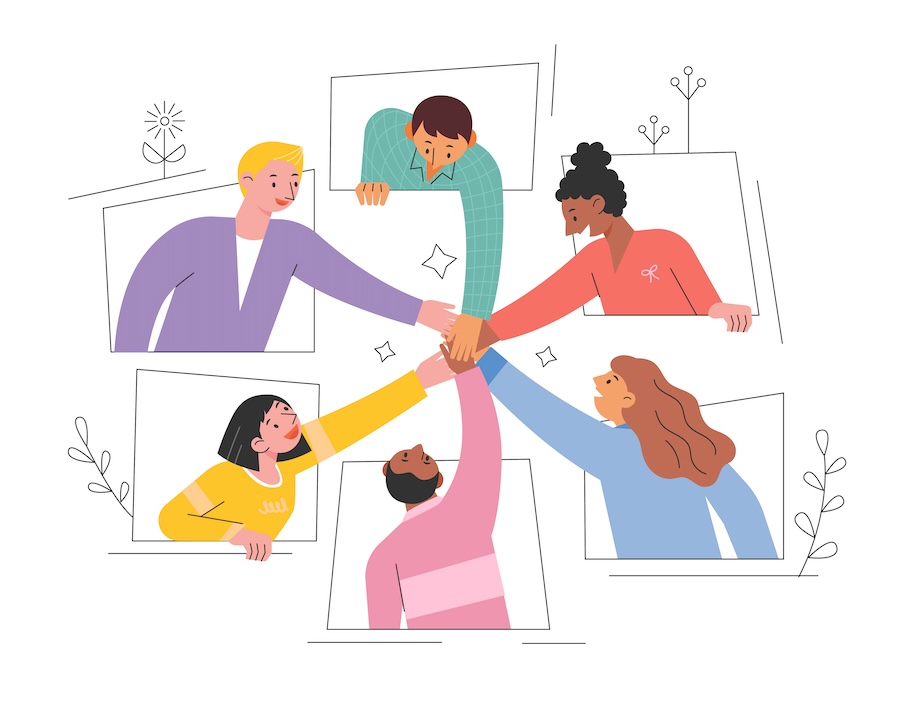Trust is the most important currency for any photography business. It’s critical if you want to grow your profits, because it builds a foundation of repeat clients and referrals—the 2 best types of clients you can find.
At Honcho, we’ve been running our own event photography and photo booth business for 7 years. 30-40% of our bookings are from repeat clients, and an additional 10% comes from referrals.
In other words, close to 50% of our business comes from trust. It’s a massive component of our success.
There are no tricks or shortcuts to building trust. You just have to remember the following.
Trust = consistency + time
Trust comes from knowing what to expect. Hence, you have to be consistent in many aspects of your photography business—and consistent over a long period of time.
Let’s look at the different ways that you can be consistent and build trust over time.
1. Provide World-Class Customer Service

The problem with cliches is that they lack specificity and usefulness. Yes, we all know that customer service is important.
As a business owner, the question is what makes good customer service, and how do you provide it?
The way we think about it in our own business is in terms of speed and thoughtfulness.
Speed is an important component of good customer service. How quickly you get back to someone matters a lot—probably more than you think.
There’s a big difference between taking a couple of hours to reply to your clients, and taking a couple of days.
For us, we set our standard at 4 hours, between hearing from a client and getting back to them.
Here’s the interesting thing—a majority of our 5-star reviews on Google mention our responsiveness. They don’t talk about the quality of the photos, the equipment we use or our photo editing.
They just talk about how quickly we respond to them. That’s how much it’s at the top of mind for them.
The second component of customer service is thoughtfulness. It’s putting ourselves in the shoes of our clients, and trying to see from their perspective.
That can translate into many things. For example, we try to be accommodating to different requests (within reason), because we know how frustrating it can be to work with someone who always says no.
If a client wants all of the unedited photos, we say yes—even though many photographers have reservations about providing that.
If a client wants to edit 10 photos within an hour from the end of an event, because they need them for their press release—we find a way to get it done.
If a client wants us to stay 30 minutes after the event, just to get a photo of their event organizing team as a favor—well, we love doing favors because it builds goodwill.
We take a positive mentality towards our clients’ requests, because we want to be more than just photographers to them—we want to be their trusted partners working together for their success.
2. Honest and Transparent Communication
I’m sure we have all had the experience as a customer, where we didn’t quite trust a business because they didn’t seem to be transparent. Perhaps we felt that they would say anything just to close a deal, or they were not being upfront about their prices.
As a photography business owner, you want the experience of working with you to be the direct opposite of that.
Honesty and transparency comes into play at every stage of a client’s lifecycle.
Let’s take a look at each stage.
Before a client becomes a client, they start off as leads—someone who enquired about your services.
Resist the temptation to say anything in order to close a deal. It’s absolutely critical to set the right expectations from the very beginning, if you want your clients to trust you.
For us, we often provide advice that actually hurts us in the short term.
For example, we’ll recommend our clients to go with a cheaper package if it’s more than enough for their needs.
Or we’ll tell them if we can’t get a job done, and recommend them to someone else.
It starts off the relationship at the right footing, by setting the right expectations and being transparent about what you can and cannot do.
The next stage comes after the deal is closed.
At this point, we want to be as detailed as possible about the various aspects of our service. For example, we’ll talk about what time we’ll show up at the event, how many edited photos they can expect, and the turnaround time for editing.
This ensures that there are no surprises, whether from a lack of communication or miscommunication.
What happens if something goes wrong, which inevitably will happen?
At this point, we believe in over communication.
What do we mean by that?
When things go wrong, a natural response is to want to run and hide. After all, no one likes an unpleasant conversation with an unhappy client.
In fact, the right thing to do is the opposite—and that is to communicate even more than usual. This shows that you’re not shrinking from your responsibilities.
For our photography business, we follow a set of guidelines in these situations.
First, it’s crucial to acknowledge the situation and empathize with the client’s frustrations—so that they feel heard and understood.
Next, apologize by taking responsibility for the issue without being defensive. Explain any extenuating circumstances.
Finally, take action to resolve the issue, if possible.
If that’s not possible, explain how you’ll take steps to prevent the issue in the future. Of course, that’s little comfort for a client who had to suffer a loss, so you can consider offering something in return—whether that’s a discount for future bookings, a free portrait shoot or a partial refund.
When things go wrong, it can feel like the world is ending.
However, if you have a good recovery process, you can turn things around.
Surprisingly, a bad situation can help to strengthen the trust that your clients have in you, because now they know how you’ll react.
There have been multiple cases where we thought we had lost a client for good, only for them to return because of how well we recovered from a bad situation.
3. Create Social Proof

Social proof is a powerful concept in marketing, where people are influenced in their decision making by others.
It’s essentially a shortcut in helping you build trust with potential clients, by providing evidence of other happy clients.
If you look at it from the perspective of your clients, there is often no way to know the quality of your service until they hire you.
It’s a risky decision that requires a leap of faith, and your job is to reduce that risk.
That’s where social proof comes in—in the form of reviews and case studies.
Of course, the challenge is how to get more of them—the majority of satisfied clients never bother to leave any.
Here’s the thing—there is no secret to getting more reviews. You just have to ask.
I know that it can feel awkward and uncomfortable to ask for reviews. You don’t want to feel like you’re pressuring your clients. After all, they’re already paying for your services.
But it’s one of those things you just have to get used to, without getting too pushy about.
The trick is to ask for a review at the point when the client is the most satisfied about your service.
Often, this is when you deliver their photos. If you have done a good job, your service will be at the top of their mind, and they’ll be more likely to leave a review.
The other trick is to ask more than once. For us, we follow up with another request a week later.
Just because someone didn’t leave a review doesn’t mean that they don’t want to—they could just have been busy when you asked the first time.
Case studies are slightly different from reviews. Use them to highlight major projects, well-known clients or unique features.
For example, we offer a unique live sharing feature—which allows us to instantly share the photos with the guests at an event, via face recognition.
Case studies are great for highlighting this feature and how it helped our clients achieve their goals. Some clients simply wanted to provide a better experience for their guests, while others wanted to empower their guests to share those photos.
4. Consistent Shooting and Editing Style
We don’t walk into a McDonald’s because we love their food. We go there because we know that they will give us the same experience, time after time.
That consistency has built them into a billion dollar business.
We want to offer the same consistency for our clients. Before they even hire us, they already know the experience they are going to get.
And that is fast response times, honest and transparent communication, and a partner who shares in their success.
That’s why we get so many repeat clients.
But at the end of the day, the end product of a photographer is the photos. So you need to have a consistent shooting and editing style.
No client wants photos that look totally different from your portfolio. That’s false advertising.
In order to achieve a consistent style, we do a couple of key things.
First, we try to have consistent lighting and composition, especially when it comes to event photography and corporate headshots.
Yes, we understand that creativity is important, and creativity comes from experimentation.
But most of our clients are not looking for experimentation. They are looking for a predictable end product that’s similar to our portfolio.
Obviously, your mileage will vary depending on the type of photography you specialize in. But it underlines the importance of clear communication of expectations.
Second, we edit all of the photos ourselves. For larger scale events, we might need to hire external photographers. If we left the editing to each photographer, the final product would be a mishmash of different editing styles.
Hence, we want to maintain control over the editing process. This also allows us to maintain control over the turnaround time, since timeliness is just as important to consistency.
5. Build Authentic Connections

People don’t want to work with faceless companies. They want to work with other people.
That’s why it’s important to put a name and face to yourself, and anyone else in your company.
This applies to any interaction point with your clients.
For example, when you communicate by email, don’t do it from a general email address—like customerservice@example.com. There’s no quicker way to make your clients feel alienated.
Do it from your personal email address, like john@example.com.
In fact, why not add a profile photo in your email signature. It’s way more personal.
One of the most powerful ways you can interact with potential clients is at your shoots—especially for weddings and events.
This is when you get face-to-face with the guests, some of whom might be looking for a photographer in the near future.
We’ve found that the most powerful way to create authentic interactions is by using the live sharing feature from Honcho.
Live sharing allows us to send the photos instantly to the guests, via face recognition or QR code.
This gives us a legitimate reason to naturally start conversations with the guests. We get to showcase our work to them, provide them something of value (their photos), and leave our contact with them (which they can access through the gallery)—all in one go.
Not to mention the wow effect of getting their photos right away. It makes our service stand out and is a key selling point—without us having to do any selling.
Conclusion
When you focus on building trust, it puts you in the right frame of mind—building for the long-term future of your photography company.
After all, most of us want to build companies that can stick around for a long time.
Trust is the foundation of that. It helps you get more clients—and just as importantly, it keeps them coming back again and again.
When you think about building trust, think about the processes that you can implement, so that you can execute consistently over a long period of time.
We’re not looking for quick fixes. We’re looking to build the foundations of your castle, brick by brick.



